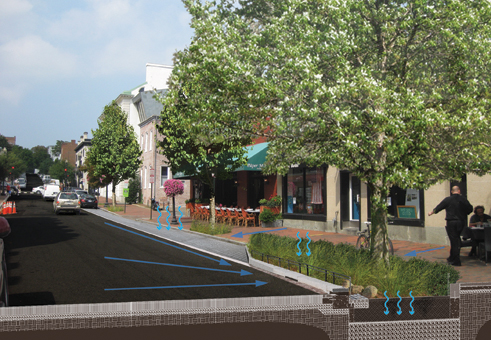DC Water Invests in Green Projects

By Katie PearceCurrent Staff Writer
The District is getting ready to devote more than $1 million to transform several sites into models of green infrastructure, with potential features like permeable bike paths, streetside vegetable gardens and inverted cafe umbrellas that collect water.
Seven teams just made it through the design phase of the D.C. Water and Sewer Authority’s “Green Infrastructure Challenge,” which explores innovative ways to control stormwater runoff.
Although other U.S. cities have hosted similar challenges, the D.C. contest is unique in that it will actually see some of the ideas through construction, according to Bethany Bezark of the water authority. Two to four of the teams will execute their projects in 2015, she said.
“A lot of times these things are just at the conceptual level,” said Bezark. “We’re actually going to be awarding funds to go into construction.”
“Green infrastructure” refers to solutions such as green roofs, rain barrels and pervious pavement that help absorb rainwater instead of allowing it to flood into sewer systems and ultimately waterways. The D.C. challenge, launched last April, invited firms to create bold new designs for public, private and institutional spaces.
“We were seeking innovative projects really pushing the line of what green infrastructure could be,” said Bezark.
Two of the winning teams presented ideas for enhancing D.C.’s small parks, two others “maxed out infrastructure as much they could” on specific streetscapes, and others proposed more focused projects, according to Bezark.
The vision from the CH2M HILL firm highlights a specific corner of Brightwood, but it presents a design that could be replicated at more than 75 “triangle parks” throughout the District. “There are so many of these traffic triangles here, following the L’Enfant Plan,” said Laurens van der Tak, vice president of the firm.
In addition to new plantings, the project would bring in features like winding, naturalistic “bioswales” designed to remove pollution from stormwater. But the plan also looks at potential economic and social benefits, like higher property values from enhanced landscaping as well as partnerships with local schools.
For the focus area along Illinois Avenue NW, CH2M would explore teaming up with the Truesdell Education Campus. “We think we can engage with the school next door, and have them participate, perhaps even in construction or planting,” said van der Tak. “We’d probably reach out to the science teachers.”
Nearby, for a residential stretch of Kennedy Street NW, another team offered a “Complete Street” that offers such amenities as bike lanes and curb extensions along with with green technologies like underground stormwater storage, which recharges water into the ground instead of the sewers.
“It was important for us to demonstrate environmental stewardship not only in terms of water and the environment that we can measure, but in terms of the health of human beings,” said Nicole Holmes of Nitsch Engineering, one firm behind the “Kennedy Greened” design.
“Some of the techniques actually lend themselves to one another,” she added. The curb extensions, for example, not only allow for metal dams to slow down stormwater but also increase pedestrian safety by narrowing crossings.
Holmes said her team was drawn to the row house neighborhood in part to engage residents. “We felt that having our design on the street where people live everyday could potentially offer more opportunities to inspire and influence awareness and advocacy.”
Another proposal, focusing on a section of Prospect Street in Georgetown near Wisconsin Avenue, would add “water collection canopies” — essentially inverted umbrellas — to outdoor dining spaces. This technology helps route stormwater to special planters and storage areas instead of to sewers, said Fernando Pasquel, director of stormwater and watershed management for the ARCADIS firm.
Another proposal for Prospect Street features biofilter zones, solar-powered lighting, and movable planters that function as herb and vegetable gardens. And a third Georgetown project — west of Wisconsin Avenue between M Street and the C&O Canal — highlights a “blue roof” designed to store rainwater.
The other winning teams focused on improvements to Lamont Park in Mount Pleasant, and a plan to convert vacant lots into “stormwater parks.”
An awards ceremony was held last week for the seven teams, which each received $10,000 toward their design costs, according to Bezark of DC Water. The remainder of the contest’s $1 million will go toward implementing the plans of the final subset of winners, she said.
The challenge helps carry out the goals of a 2012 green infrastructure partnership agreement between the District and the U.S. Environmental Protection Agency. It also might help the city address its long-term control plan for “combined sewer overflow,” which is now highly dependent on a proposed tunnel system to the Blue Plains Advanced Wastewater Treatment Plant. Bezark said a public comment period would begin soon on modifications to that plan that incorporate more green infrastructure.
More information on the Green Infrastructure Challenge, including links to the winning designs, is available at dcwater.com/greenchallenge.
This article appears in the Jan. 15 issue of The Georgetown Current newspaper.




